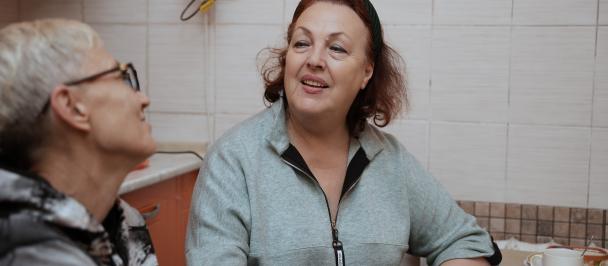Tried and tested: Effective strategies for the HIV response begin with communities
December 12, 2023

A new UNDP review identifies tactics, strategies and approaches to remove barriers to HIV services, led by communities, especially people living with HIV and other key populations.
Recent developments have shown that reaching the global HIV targets is not only possible, but within reach for some countries. High burden countries, including Botswana and Zimbabwe, have achieved the 95-95-95 targets, while a further 16 countries are close to doing so. Mauritius recently joined a growing list of countries to decriminalize same-sex relations, an important step towards achieving the 10-10-10 targets, which countries committed to as part of the 2021 Political Declaration on HIV and AIDS.
There are many factors contributing to these advancements, but time and time again we have seen that successful HIV responses are led by communities, especially people living with HIV and other key populations and grounded in human rights.
A new UNDP review of tactics, strategies and approaches for removing and reforming punitive and discriminatory laws reinforces what many involved in the HIV response have known all along: communities, especially people living with HIV and other key populations, know best how to do this.
The 14 tactics described in the review have been critical to the implementation of the Global Commission on HIV and the Law’s recommendations, particularly in the face of existing and worsening violence, stigma, discrimination and HIV-related criminalization. Here, we showcase three tactics that highlight the leadership of people living with HIV and other key populations: community mobilization, creating safe space to engage with decision makers and direct action. These approaches are, among others, central to scaling up progress on the 10-10-10 targets and ending AIDS as a public health threat by 2030.
For details on all 14 tactics, strategies and approaches, please read the newly published Evidence Review.
Community mobilization: Locally driven change is key to success
Community leaders that are resourced and supported can galvanize action against legal and policy barriers and further public awareness of HIV-related issues in their communities.

Through the SCALE Initiative, UNDP and partners offer grants to key population-led organizations, such as Fundación Iguales in Panama, that are working to improve legal and policy environments for the HIV response.
In the Cook Islands, building on investments from UNDP and the Global Fund to Fight AIDS, Tuberculosis and Malaria (Global Fund) investments, communities mobilized to advocate against the prohibition of consensual sex between men, leading to the removal of the law earlier this year. As documented in the review, when the United Belize Advocacy Movement (UNIBAM) was able to register as an NGO, the organization went on to advocate for HIV policies that reflected the needs of men who have sex with men and paved the way for other LGBTI organizations to register as NGOs. In Indonesia, various key population organizations and people living with HIV worked together to help postpone voting on amendments that would have effectively criminalized sex work and created additional penalties for drug offences.
Community mobilization must be sustained and strengthened through financial and technical assistance, especially against a backdrop of shrinking civic space. That is why UNDP is leading the SCALE Initiative together with a number of global partners to support organizations led by people living with HIV and other key populations. Through its grants, SCALE is supporting a range of tactics and approaches on the path to law reform, including for Fundación Iguales in Panama to continue its community mobilization work helping other trans-led and -focused organizations obtain legal status.
Engage with decision makers: Better decisions are made when key populations are meaningfully included
Creating safe space for engagement with affected communities allows decision makers to hear first-hand experiences of discrimination, leading to better-informed and more effective policies and legislation. Programmes like UNDP’s #WeBelongAfrica increase the capacity of LGBTI+ people to influence decision makers for better HIV outcomes for all. The Africa Key Population Expert Group (AKPEG), which has been supported by UNDP for a decade, seeks to increase engagement of key populations in HIV-related law and policy efforts. AKPEG facilitated the inclusion of transgender persons in the drafting of national strategic plans and the establishment of the East Africa Trans Health and Advocacy Network in Kenya, allowing for improved dialogue with decision makers.

Representatives from The National Association of PLWHA (NAP+N) meet with the Nepal National Centre for AIDS And STD Control.
This engagement can be strengthened through the creation of formalized structures within policymaking processes. In recognition of this, the Global Fund requires that non-state actors make up 40 percent of the national bodies overseeing the implementation of their programmes. The Philippines has gone one step further, creating a formal key populations committee to ensure they have the resources and understanding of Global Fund processes needed to meaningfully participate. In Ukraine, civil society organizations led by people who use drugs are integrated into government working groups, where they are able to support policies and laws that abate discrimination.
Direct action: Change comes from the ground up
Direct advocacy, which includes rallies, protests, petitions and more, can raise awareness of specific rights violations among the public and increase pressure on decision makers. We have seen the positive effects of this kind of focused advocacy play out since the first reports of AIDS in 1981. In fact, the HIV movement has a strong legacy of leveraging direct action, notably with the AIDS Coalition to Unleash Power (ACT UP) in North America engaging in public protests, demonstrations and die-ins in the 1980s.
More recently, sex worker coalitions, networks and organizations have established sex worker pride marches to strengthen their movement and call attention to human rights violations, which we have seen lead to positive developments in countries such as South Africa. Sisonke National Movement in South Africa is leveraging this opportunity to conduct a series of direct-action campaigns over the coming months on the human rights of sex workers, which is an intrinsic component for both increasing their access to integrated services and reducing their vulnerability to HIV.
Many of the tried and tested approaches described in the Evidence Review highlight the fact that the pathways to law and policy reform are not linear, and that interventions like those described above are almost always used in conjunction with each other. And this list is not exhaustive. This review reaffirms the tactics people living with HIV, key populations and other communities have been using, often to success. It also provides a roadmap to replicate and an evidence base to expand upon and learn from. Continued mobilization and advocacy by and for affected communities, especially people living with HIV and other key populations – with the investment and support of partners and the multilateral system – is critical if we are to scale what works and end AIDS as a public health threat by 2030.

 Locations
Locations






